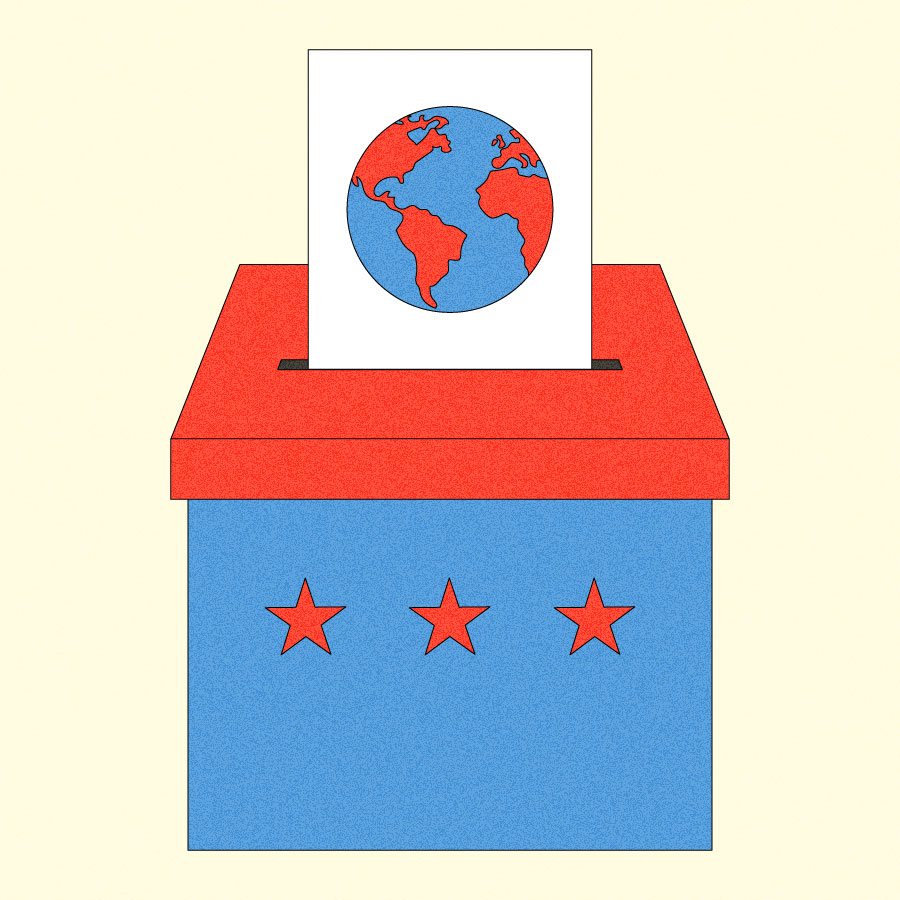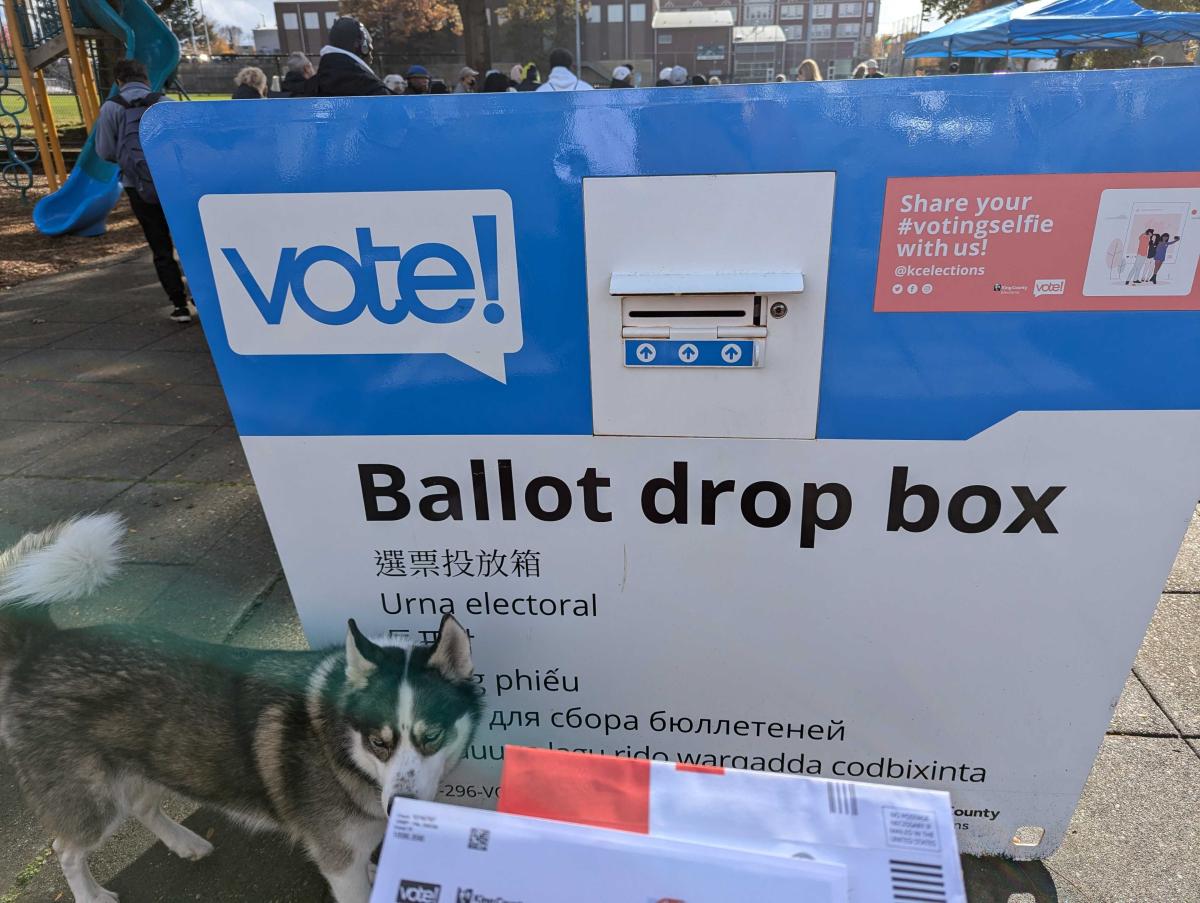
The vision
“For so long, we’ve assumed that when the climate crisis got bad enough, everybody would just wake up, come together, and solve it in some grand ‘kumbaya’ moment — and that’s not necessarily how the story will go. When crises get worse and scarcity gets worse, sometimes it gets harder to love your neighbor. And there is no doubt in my mind that the empathy and respect we will need for our fellow citizens in order to address the climate crisis can only exist in a healthy democracy.”
— Nathaniel Stinnett, executive director of the Environmental Voter Project
The spotlight
Climate change poses a threat to democracy. That threat has manifested in some immediate ways this year, with freakishly strong hurricanes ripping through the southeastern U.S., damaging roads and polling places and interrupting mail service. Researchers have also found that the impacts of climate change could provide fertile ground for authoritarianism.
On the flipside, participating in democracy is crucial for ambitious climate policy. You’ve almost certainly heard it before: One of the single most important things you can do to make your voice heard and stand up for the issues you care about is vote.
“I think it is worth stressing that we have an absurdly large number of solutions to all of the climate problems we are faced with,” said Nathaniel Stinnett, the executive director of the Environmental Voter Project. “We just have politicians who don’t want to enact those solutions — and that lack of political will to force politicians to lead on climate is a real problem.”
He founded the Environmental Voter Project to address that problem, by identifying environmentalists who don’t vote and using behavioral science to try and turn them into more consistent voters — creating a stronger voting bloc for the climate. “At the end of the day, politicians always go where the votes are because they love winning elections,” Stinnett said. “That, more than any other reason you can come up with, is why anybody who cares about climate change needs to show up and vote, because it’s power just sitting there waiting for us to grab it.”
The organization is driven by data — and it’s already seeing some promising results for 2024. According to a press release shared on Monday, over 214,000 first-time climate voters have already cast ballots in the U.S. presidential election, across the 19 states the organization works in. And in some key swing states, climate-identified voters generally seem to be outperforming other early voters. In Pennsylvania, for instance, 12.8 percent of registered voters had already cast ballots, and 21.7 percent of climate voters had, Stinnett told me when we spoke last week.
Still, participating in democracy remains easier for some than others. Voter suppression is alive and well in 2024, as some groups, fueled by the conspiracy theory that the 2020 election was stolen, are ramping up efforts to purge voter rolls, among other tactics. And those efforts hurt the climate movement.
“Laws have been put in place that are designed to make it harder for young people and people of color to vote,” Stinnett said. “And this has been historically the case — there’s nothing shocking or new about this — but we continue to see in our data that young people and people of color are the heart of the modern environmental movement. And so these laws disproportionately impact the climate and environmental movements.”
The pernicious thing about voter suppression, he said, is that it seeps into cultural consciousness. When people believe that voting is complicated — or when they are aware that it is, in fact, more difficult for them than for others — they may simply opt out.
The Environmental Voter Project is one organization working to combat this, by sharing information to demystify the process and helping people make a plan to vote.
You, too, can help make it easier for more people to cast their votes — in some low-key (and even fun!) ways. If you’re feeling an ever-increasing sense of anxiety and dread in these waning days before the 2024 election (hi! same!), getting involved may be one way to quell those feelings. Read on for five ways you can help get out the vote.
![]()
Making calls and knocking on doors
Environmental Voter Project has opportunities for volunteers looking to make calls to voters, specifically targeted to non-active voters who list the environment as their top concern. “Just over the last five days of the election, so November 1 through November 5, we’re looking to fill 4,825 phone-banking shifts,” Stinnett said. Modern phone-banking technology enables volunteers to do this from a computer, using a system that automatically dials the target numbers and shows the calls as coming from the organization, shielding the individual volunteer’s phone number. Find out more here.
The organization also has canvassing opportunities for environmental voters in Philadelphia; Pittsburgh; Austin, Texas; and Tucson, Arizona. If you’re in any of those cities and interested in going door-to-door to get out the vote, you can sign up here.
Lead Locally is another organization working to rally the environmental vote, by focusing on building support for down-ballot candidates with strong climate platforms. It has two more “Calls for Climate” events before election day — one is today, October 30, and another is Monday, election eve. You can learn more and sign up here.
Offering rides to the polls
Do you have an electric car? And do you live in Arizona, Florida, Georgia, Kentucky, Michigan, Nevada, North Carolina, Ohio, Pennsylvania, Texas, or Wisconsin? If so, you can volunteer to give people rides to the polls with ChargeTheVote, a nonpartisan initiative to boost voter turnout and slash transportation emissions on Election Day. Learn more here.
If you don’t drive an EV, there are still ways to help out with transportation. Look for groups in your area — for instance, Drive Your Ballot is one nonprofit operating in Pennsylvania, coordinating volunteer drivers as well as volunteers who can help organize ride dispatches. Check it out here.
And you can always take a more personal approach, too: Plan a voting carpool with friends, family, coworkers, etc. Studies have shown that something as simple as making a plan with someone can increase the likelihood that a person will follow through on their intention of voting.
Getting free food to voters in long lines
Beyond simply getting there, a long line at the polls can be a formidable barrier for many — and, historically, voters in Black and brown neighborhoods face longer wait times on Election Day. Having access to food and water can help ease some of the burden of having to wait. Pizza to the Polls coordinates pizza deliveries (it also has a food truck program) to places where there are long lines. Anyone can report a crowded polling location online and then help coordinate the pizza delivery. There’s also an option to preorder, for nonprofits and other groups planning events for voter registration and turnout.
Do keep in mind that every state has some form of restrictions on the activities that can take place near voting locations, and for some, that extends to offering sustenance (sometimes known as “line warming.”) For instance, in Georgia, it’s illegal to offer free food or water within 150 feet of a polling place. Still, local groups are finding ways around these restrictions.
Supporting a voting holiday
What about the bigger picture, you might ask? There are, of course, many ways that states and the national government could make it easier for people to vote. One idea is to make Election Day a federal holiday, so that working people would be able to make it to the polls more easily.
If you like that idea, and if you’re the sort of person who calls up your representative in Congress (or if you’re even curious about calling up your representative in Congress) you could do so to express support for the Election Day Holiday Act, a bill introduced by California Representative Anna Eshoo this year.
Talking, texting, and posting about it
If you’ve made it this far in the newsletter, you probably care at least a little bit about voting, and ensuring that others are able and motivated to vote, too. A final, very simple action you can take to encourage those around you to vote is to let them know that you have.
“Often the best thing you can do is be loud and proud about the fact that you are a climate voter,” Stinnett said. “We think it’s so satisfying when we can rationally convince people to do things. But the truth is we’re more social animals than we are rational animals.”
He cited a 2012 study published in Nature, which found Facebook users were more likely to vote when they received a message about voting that included profile pictures of their friends who had already voted. It may sound silly, Stinnett said, but human beings are constantly looking at one another to figure out what behavior is good and appropriate. Don’t waste time (and emotional labor) trying to craft the perfect argument to convince somebody to vote, he said. “If you, on social media or in real life, make it very clear that you are a voter because that’s integral to who you are as an environmentalist, or as a good neighbor, or as a good child, or as a good parent, then anybody else who wants to be those things will say, ‘Oh, I wanna be a good environmentalist, so I should vote, too.’”
— Claire Elise Thompson
A parting shot
In the spirit of being a loud and proud voter, here is a picture of me (and my dog) dropping off my own ballot yesterday in Seattle! I did it! As is the way in Washington state, the ballot showed up in my mailbox a couple weeks ago, and the drop box was a mere 15-minute walk from my house. (I also could have put it in the mail, with no postage required.)

This story was originally published by Grist with the headline 5 ways to get out the vote for climate in the final days before the U.S. presidential election on Oct 30, 2024.
This content originally appeared on Grist and was authored by Claire Elise Thompson.
This post was originally published on Radio Free.